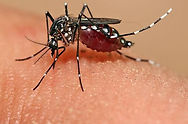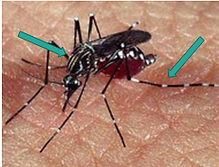
Mosquito Biology
Life Cycle
-
Egg
-
Adult, female mosquitoes lay their eggs on the inner, wet walls of containers with water.
-
Mosquitoes generally lay 100 eggs at a time.
-
Eggs are very hardy; they stick to the walls of a container like glue and can survive drying out for up to 8 months.
-
It only takes a very small amount of water to attract a female mosquito. Bowls, cups, fountains, tires, barrels, vases and any other container storing water.
-
-
Larva
-
Larvae emerge from mosquito eggs, but only after the water level rises to cover the eggs. This means that rainwater or humans adding water to containers with eggs will trigger the larvae to emerge.
-
Larvae feed on microorganisms in the water. After molting three times, the larva becomes a pupa.
-
-
Pupa
-
Pupae will develop until the body of the newly formed adult flying mosquito emerges from the pupal skin and leaves the water.
-
-
Adult
-
After adult mosquitoes emerge: male mosquitoes feed on nectar from flowers and female mosquitoes feed on humans and animals for blood to produce eggs.
-
After feeding, female mosquitoes will look for water sources to lay more eggs.
-
Aedes aegypti only flies a few blocks during its life.
-
Unlike other mosquito species, Aedes aegypti mosquitoes prefer to bite people.
-
Aedes aegypti mosquitoes prefer to live near people.
-
Mosquito Taxonomy
-
Kingdom: Animalia
-
Subkingdom: Bilateria (bilateral symmetry)
-
Phylum: Arthropoda (exoskeleton, segmented body)
-
Subphylum: Hexapoda (six legs, 3 body segments)
-
Class: Insecta
-
Subclass: Pterygota (winged insects)
-
Order: Diptera (two wings)
-
Family: Culicidae (long legs, hairy, sucker, etc)
-
Genus: Aedes
-
Species: albopictus
General Traits
-
Measures approx. 1/4 -1/2 inch in length
-
Has wings longer than its body
-
Ranges in color depending on species; many are brown
-
Breed in stagnant water
Mosquitoes vs. Midges
-
The adult midge is slender, usually less than 5mm long with long slender wings and legs.
-
They lay their eggs on water and are usually found in quiet waters, with a preference to polluted waters that contain excessive algae growth, as this is their food source.
-
They differ from the midge in that they have scaled wings and in the females; elongated mouthparts that enable them to bite.
-
The mosquito lays its eggs in any standing water and the "wrigglers", as they are called because of their swimming motion, feed on algae and other organic matter.
Mosquitoes vs. Dixid Midges
-
Dixid Midges are common around moist areas where vegetation is abundant and may be seen swarming at dusk along the edges of streams and lakes. The adults are short lived, usually being active less than a week.
-
The larvae are found in slow moving water, at the surface, and swim in a characteristic "U" shape.
-
These midges lack a proboscis and scales on the wings. Periodically, dixids can produce staggeringly large emergences, but only in local and certain ecological situations.
Mosquitoes vs. Crane Flies
-
Adults are very slender, long-legged fliers that may vary in length, from ¼ inch to as large as 1½ inches in length.
-
Smaller species are mosquito-sized, but they can be distinguished from mosquitoes by the V-shaped suture on the thorax, non-piercing mouthparts, and a lack of scales on the wing veins.
-
Some larval (immature) crane flies may on occasion feed on mosquito larvae but they do not feed on adult mosquitoes.



Mosquitoes vs. Wood Gnats
-
Wood Gnats are some of the better known gnats, for they are attracted to light and can be found near windows, especially in spring time.
-
The adults can be found all year long.
-
The larvae live in rotting plants and rotting plant parts, fermenting sap, animal manure, tree trunks, mud and sometimes sewage.
-
Adults are found on foliage in or near damp places, some are found around flowing sap.
-
They are sometimes seen in small swarms.
-
Adults appear in two variations: greyish black or reddish.


Mosquito Anatomy
Proboscis - In the middle of the antennae lies a long serrated mouthpart used to pierce the skin and suck the blood. The proboscis holds two tubes, one that injects saliva and a second that actually draws blood.
Thorax - Has a pair of wings and a pair of halteres, the legs have tiny claws at the end to help stay attached to surfaces
Spiracles - Small openings line both sides of the abdomen which allows mosquitoes to draws in air
Head - Has sensory equipment that help the mosquitoes find and feed on people and animals
Compound Eyes - Covered with tiny lenses called ommatidia that are capable of detecting slight movement on the top of their heads they have ocelli (sensitive photosensitive eyes detect variations in light)
Antennae - Long feathery organs that contain sensitive receptors that detect carbon dioxide, the maxillary palp between the antennae picks up the odors from chemicals released in human sweat
Abdomen - Serves as the mosquitoes stomach and lungs

Male vs. Female Mosquitoes
-
Abdomen holds the blood that the females take in and there is a nerve in the abdomen that signals when it is full. The female's’ eggs are also stored in the abdomen
-
Male mosquitoes have a feather-like proboscis while the female has a smooth proboscis
-
Male mosquitoes use their antennal flagellum to locate to locate female mosquitoes by listening to the quiet buzzing sounds females emit
-
Females tend to live 1-2 weeks longer than males in a natural habitat or 1 month when held in a captivity
-
Male mosquitoes feed on flower nectar and sweet juices while females feed on blood in order to gain more protein to develop their eggs, without blood the females ability to reproduce quickly diminishes

Mosquitoes in the United States
-
There are currently 176 species recognized in the United States
-
The four most common types of mosquitoes in the United States are the:
-
House Mosquito (Culex Pipiens and Culex restuans)
-
Southern House Mosquito (Culex quinquefasciatus)
-
Asian Tiger Mosquito(Aedes albopictus)
-
Yellow Fever mosquito(Aedes aegypti).
-
Mosquitoes in Virginia
-
Aedes vexans
-
Anopheles crucians
-
Anopheles punctipennis
-
Anopheles quadrimaculatus
-
Coquillettidia perturbans
-
Culex territans
-
Culex salinarius
-
Culex restuans
-
Culex pipiens
-
Culex erraticus
-
Ochlerotatus c. canadensi
-
Ochlerotatus atlanticus
-
Ochlerotatus triseriatus
-
Ochlerotatus taeniorhynchus
-
Ochlerotatus sollicitans
-
Ochlerotatus japonicus
-
Ochlerotatus infirmatus
-
Orthopodomyia signifera
-
Psorophora columbiae
-
Psorophora ciliata
-
Psorophora ferox
-
Psorophora howardii
-
Toxorhynchites rutilus septentrionalis
-
Uranotaenia sapphirina
-
Extirpated species - species that are eradicated from a particular are:
-
Aedes cinereus
-
Anopheles atropos
-
Anopheles barberi
-
Anopheles smaragdinus
-
Anopheles walkeri
-
Culex quinquefasciatus
-
Culex peccator
-
Ochlerotatus dupreei
-
Ochlerotatus stimulans
-
Orthopodomyia alba
-
Psorophora discolor
-
Psorophora mathesoni
-
Wyeomyia smithii
-
-
Introduced species- species that is not native to the area and have been brought from a foreign place
-
Yellow Fever Mosquito (Aedes aegypti)
-
Native to Africa, were first spread to all over Europe and later to the U.S from sailing ships in Africa. It is considered one of the most globally widespread mosquitoes in the world
-
-
Asian Tiger Mosquito (Aedes albopictus)
-
Native to Southeast Asia, brought to Houston, Texas by a Japanese shipment of scrap tires, these were sent to a recycling plant in Baltimore which spread the mosquitoes along the way
-
-
Aedes aegypti
Its defining trait is that it possesses lyre shaped white scales on the dorsal surface of the thorax. White basal bands that appear as stripes are present on each ¨foot¨ of the hind legs.

Aedes albopictus
It’s back is black with a distinguishing white stripe down the center starting from the head to the thorax. The average size is approximately 2.0 to 10.0 mm, males are on average 20% smaller than females. White basal bands that appear as stripes are present on each ¨foot¨ of the hind legs.

Fun Facts
Mosquito Bites
-
When mosquitoes first bite a mammal, the mammal secretes an antibody that causes the blood to coagulate into noticeable, white clumps.
-
These clumps prevent the mosquito from drinking more blood temporarily, the insect goes around this issue by continuing to probe around.
-
The reason why mosquito bites are itchy is because of the proteins and enzymes found in the mosquitoes saliva.

Attractiveness
-
About 20% of the population are increasingly attracted to mosquito bites than others.
-
500 chemicals are produced from the human body, which in turn are detected using the antennae of mosquitoes.
Mosquito Communication
-
The mode of communication for mosquitoes is from the beating of their wings.
-
The high- pitched whining sound heard from a mosquito is from a female who is searching for blood.
-
The whine attracts the attention of male mosquitoes who can detect the sound with their antennae.
-
Below the antennae of the male mosquito is the Johnston’s organ which moves with the frequency picked up from the sound, and nerve impulses signal the brain which interprets the sensation to a sound.
-
-
Interesting related fact:
-
The frequency of the sound changes as temperatures increase or decrease
-


